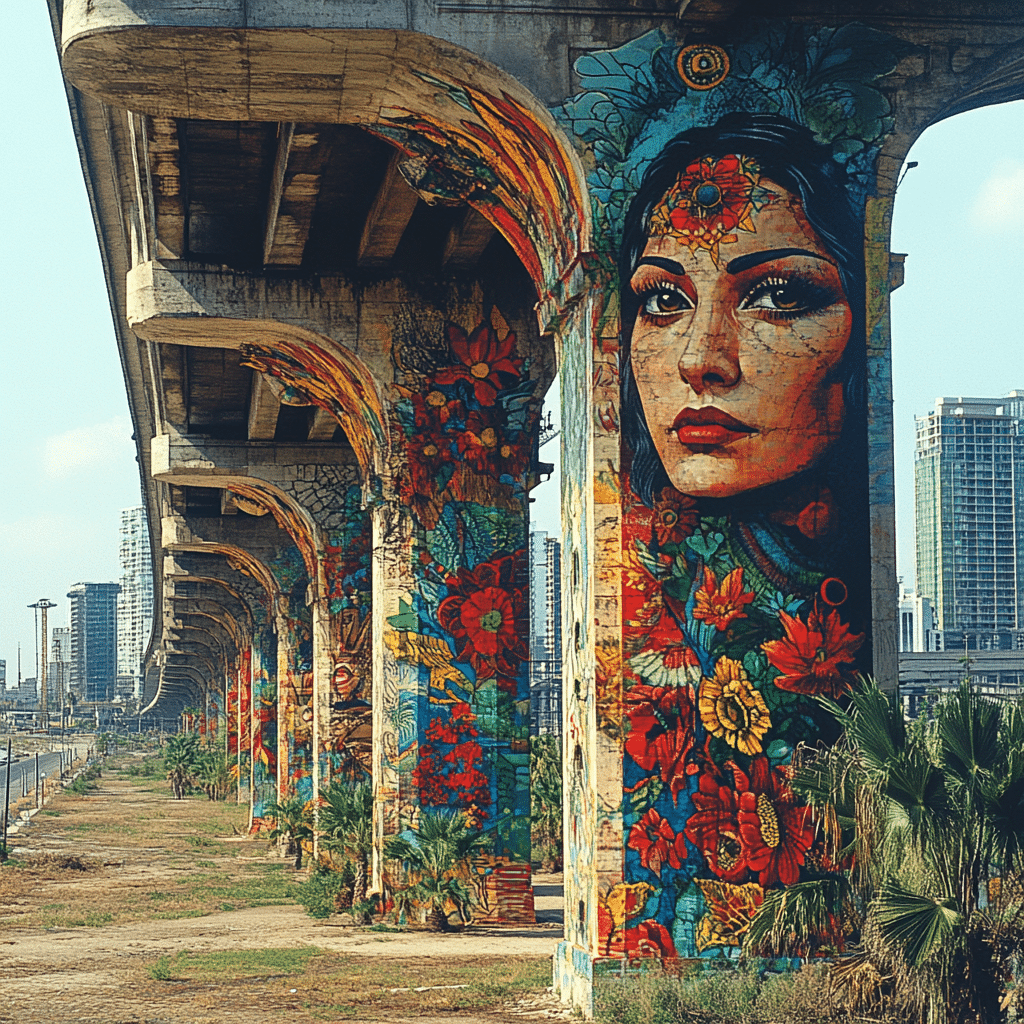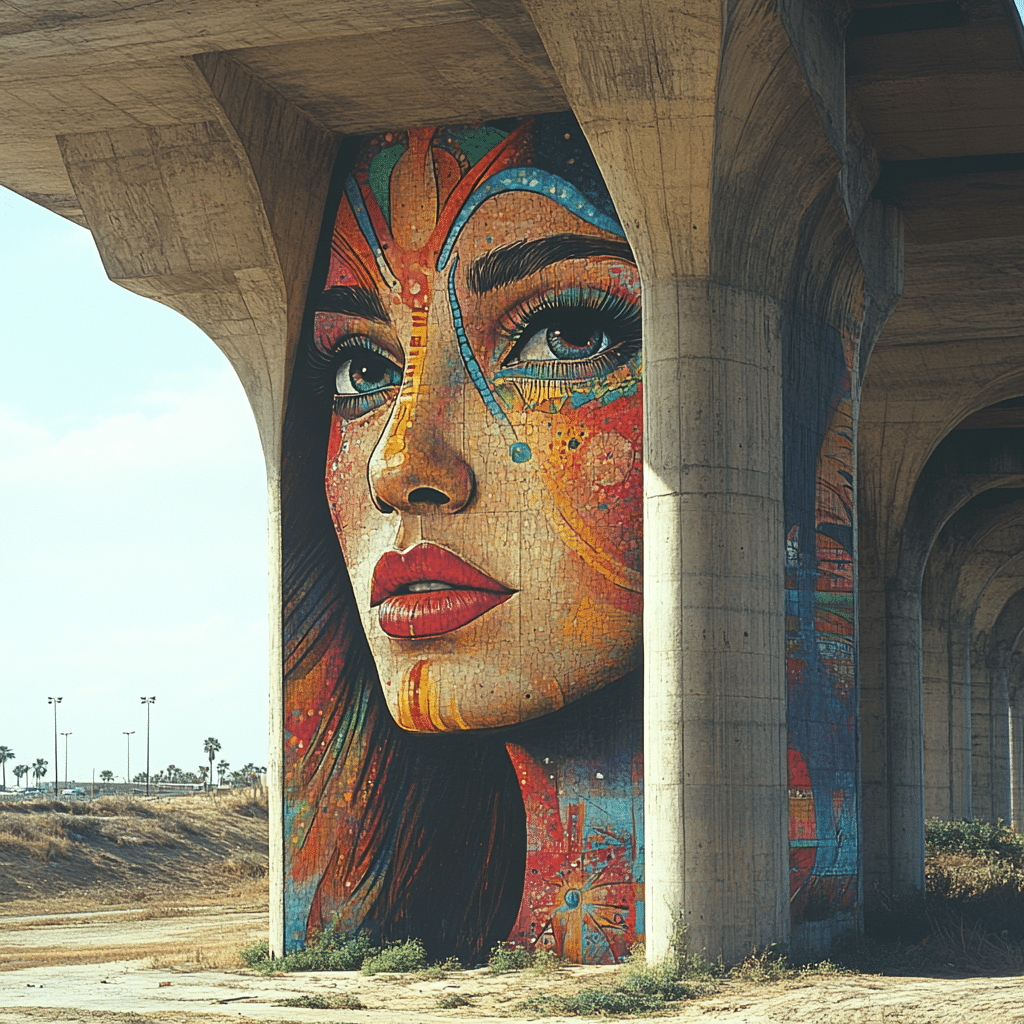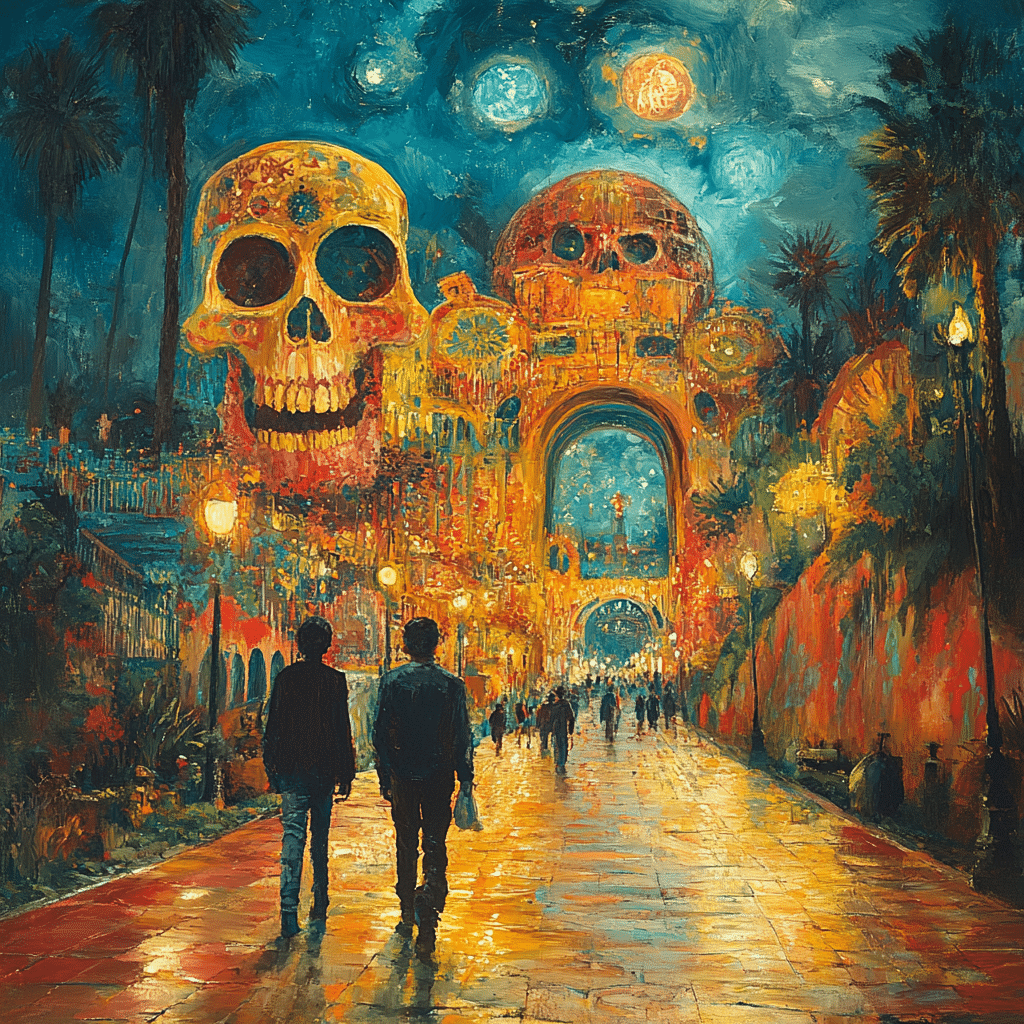Chicano Park, a vibrant community space in San Diego, California, is more than just an open area; it is a celebration of Chicano culture and art. Nestled in the heart of the Barrio Logan neighborhood, this park boasts the largest concentration of Chicano murals in the world, with over 100 vibrant paintings stretching across seven acres. Established in 1970 amid a grassroots movement, Chicano Park emerged as a fierce response against gentrification and a testament to the community’s resilience and creativity. Its walls are alive with stories that embody the hopes, struggles, and artistic expressions of the Chicano community while inviting all visitors to engage with its rich cultural heritage.
As you stroll through Chicano Park, each mural tells a story, pulling you into a colorful narrative of identity, history, and pride. It stands as a socio-political hub and a canvas that continues to evolve, reflecting the community’s dynamic spirit. The ongoing artistic projects here don’t just beautify the landscape; they actively encourage dialogue and unite residents, making Chicano Park a beacon of cultural significance. In short, each visit is not just a casual outing—it’s a journey into the heart of Chicano life and art.
As we step into 2024, Chicano Park remains a pivotal location for artistic expression and social activism. The rich history, combined with the park’s role in fostering community, makes it an essential stop for anyone exploring the artistic tapestry and socio-political narratives of modern America. So whether you’re a local or just passing through, make sure to carve out some time to soak in everything this iconic park has to offer.
A Deep Dive into Chicano Park’s Rich History and Cultural Significance
Chicano Park’s journey began in the early 1970s, as activists rallied to protect a space that was essential for community gatherings and cultural expression. This was a response to the displacement caused by urban development, which threatened to erase the rich cultural fabric of the neighborhood. A coalition formed, known as the Chicano Park Steering Committee, advocating for the land’s designation as a park to honor and celebrate Chicano culture through art. Their persistent efforts culminated in success when the California Coastal Commission agreed to the park’s development in 1987.
The murals you see today are not just decorative. They depict rich histories that include Mexican pre-Columbian gods, revolutionary struggles, and the symbolism of cultural identity. Local artists have poured their talents into these walls, transforming Chicano Park into an open-air gallery. Each mural can be a reflection of personal stories, communal struggles, and creative triumphs, forming a tapestry that connects past and present. The park embodies a spirit of cultural reaffirmation—through every brushstroke, it reclaims identity and space.
Chicano Park continues to be an important touchstone for community activism. It hosts various events, including cultural festivals and educational workshops, which draw people from all backgrounds. These activities highlight the ongoing significance of the park as a platform for art and social justice, encouraging unity and dialogue among residents and visitors alike.

Top 7 Artistic Highlights of Chicano Park’s Murals
Chicano Park is a treasure trove of artistic expression, with murals that resonate deeply with cultural meaning and beauty. Here are seven standout pieces that highlight this creative oasis:
Beyond the Murals: Events and Activities at Chicano Park
Chicano Park isn’t just about its stunning murals; it’s also a vibrant community hub, teeming with events and activities year-round. The park plays host to various festivals that celebrate Chicano culture, such as the annual Chicano Park Day. This beloved event features live music, dance performances, poetry readings, and an array of delectable food vendors, all aiming to unite the community and showcase rich traditions.
Another highlight is the educational workshops that occur regularly, focusing on art, culture, and social issues. These events foster a deeper understanding of Chicano heritage while bridging the gap between generations. Encanto Park, located nearby, offers a lovely contrast with its lush greenery, perfect for family gatherings and leisurely strolls.
If you’re looking for entertainment beyond the park, head over to the Santa Cruz Cinema or the Los Cerritos Center. Both venues offer a blend of shopping and cinematic experiences, making for a full day of cultural immersion. The park not only enhances your appreciation for art but also offers diverse activities that enrich your San Diego experience.

Cultural Resonance: Why Chicano Park Matters to the Community
The significance of Chicano Park transcends its physical boundaries. It stands as a testament to the unwavering resolve of a community that fights for recognition and respect. In transforming a neglected space into a thriving cultural landmark, artists and leaders have crafted a legacy that embodies themes of identity, resistance, and unity.
Moreover, as more visitors flock to Chicano Park, it sparks vital conversations around relevant social justice issues that persist today. The park invites everyone to not only appreciate its beauty but also to engage in meaningful discussions that encourage growth and reflection. It remains a critical space for dialogue and activism, reminding us that art and culture play powerful roles in societal change.
Chicano Park continues to inspire future generations, encouraging individuals to find their voices through artistic expression. The park’s ever-evolving nature allows it to maintain relevance in an era when representation matters more than ever.
Exploring Nearby Cultural Sites: A New Perspective
Enhancing your visit to Chicano Park is easy when you explore nearby cultural sites. Just a short drive away is Sombrero Beach, a relaxing retreat perfect for sun-soaking. After absorbing the art in the park, lounging by the ocean serves as a refreshing contrast, allowing you to reflect on the powerful narratives you’ve encountered.
For a touch of tranquility, consider visiting Descanso Gardens. This serene location not only showcases breathtaking botanical gardens but also features art exhibits that echo themes similar to those found in Chicano Park. It’s an excellent way to continue delving into matters of cultural preservation and connection to land.
Don’t forget to check out The Corner bar; it offers a cozy atmosphere with delicious food and drinks, perfect for winding down after a day filled with culture. These sites help create a multifaceted travel experience that honors the richness of San Diego’s diverse heritage.
Closing Thoughts: Chicano Park as a Living Canvas
Chicano Park is not just a place to visit; it’s a living canvas where history, culture, and art converge. Each mural, event, and activity adds a new layer to the ongoing narrative that speaks volumes about the Chicano community. As we journey into 2024, the park flourishes, embodying resilience and creativity that both locals and travelers can appreciate.
So next time you find yourself in San Diego, take a moment to engage with Chicano Park. It invites everyone—tourists and residents alike—to reflect, learn, and celebrate a rich tapestry of experiences. This enduring legacy serves as a reminder of where we’ve been and inspires us to carve out our artistic voices in our communities. Whether you’re drawn there for the stunning art, community spirit, or cultural resonance, Chicano Park promises to leave a lasting impression on your heart and mind.
Chicano Park: A Vibrant Celebration of Culture and Art
Fun Facts about Chicano Park
Did you know Chicano Park is home to the largest collection of outdoor murals in the U.S.? This colorful space, which lies under the San Diego-Coronado Bridge, showcases over 80 murals portraying Mexican-American history and culture. These vibrant artworks are a testament to the creativity and resilience of the Chicano community. Picture this: while strolling around, you might stumble upon a mural that captures the essence of local legends or even the spirit of hot summer days, akin to those captured in popular hot Women Gifs that embody Californian flair.
Now, let’s dive deeper! Chicano Park isn’t just about stunning visuals, though. It has roots planted in activism. Established in 1970 after a community fight to reclaim the land, the park symbolizes the ongoing struggle for rights and recognition. On top of that, its cultural dimensions are supported by various events throughout the year, including the annual Chicano Park Day festival, celebrating art, music, and the culture of the barrio. The park retains its vitality, much like the ever-changing scenery you’d find in the The falls.
Curiosities Beneath the Surface
You may not know it, but some of the muralists were initially inspired by the works of notable artists and movements worldwide, including influences from Hong kong Chinese art forms that emphasize community and tradition. This blending of styles highlights the park’s role as a confluence of different cultures. Plus, the park continues to evolve, attracting not only locals but visitors in search of captivating stories and experiences. Just like the creativity sparked in playful online communities such as Thinknoodles, the vibes in Chicano Park encourage everyone to express themselves.
And there’s more! Did you know this iconic park has been featured in various films and media? Its artistic essence has drawn attention from creators and onlookers alike, solidifying its place in pop culture. For a bit of nostalgia, one might even liken the park’s heritage to the stories of timeless actors like Robert Fuller. With every visit, there’s a new layer to uncover, just like discovering intriguing tales of unexpected connections, including the diverse narratives of Japanese lesbian communities that add to the rich tapestry of human experience. Chicano Park is a living gallery filled with history waiting to be explored!

What happened to Chicano Park in 1987?
In 1987, after a long fight, the Chicano community’s efforts paid off when the California Coastal Commission agreed to turn the land at the foot of Crosby Street into Chicano Park, providing a space for cultural expression.
What do the murals mean at Chicano Park?
The murals at Chicano Park tell powerful stories through vibrant images, showcasing Mexican heritage, pre-Columbian gods, revolutionary struggles, and elements of Chicano identity, reflecting the community’s cultural history and resilience.
Why did the Chicano community want Chicano Park?
The Chicano community pushed for Chicano Park to create a space where their culture could thrive and be celebrated, ensuring their history and identity were represented and honored through art.
Does Chicano Park have a playground?
Yes, Chicano Park has a playground where kids can play and have fun, making it a great spot for families to enjoy outdoor activities together.
What is Chicano Park most famous for?
Chicano Park is most famous for having the largest collection of Chicano murals in the world, with over 100 stunning paintings that celebrate the rich culture and history of the Chicano community.
What ended the Chicano Movement?
The Chicano Movement didn’t end abruptly; instead, it evolved over time, transitioning into various social and political movements as activists continued to fight for rights and equality into the late 1970s and beyond.
What does hasta la bahia mean?
“Hasta la bahia” translates to “Until the bay” and symbolizes a sense of movement and aspiration within the Chicano community, often used to express hopes for freedom and justice.
Who are the Chicano Park artists?
Chicano Park is home to many talented artists, including local muralists who dedicated their works to expressing Chicano culture, history, and social issues, often collaborating on large-scale projects.
What makes Chicano murals unique?
Chicano murals stand out due to their rich symbolism, vibrant colors, and the way they convey the struggles and achievements of the Chicano community, all while serving as a public canvas for expression.
What protest built Chicano Park?
Chicano Park was created through passionate protests led by activists who demanded the land be designated for community use, allowing for creativity, culture, and pride to flourish.
What makes Chicano culture?
Chicano culture is characterized by its blend of Indigenous and Mexican traditions, language, music, art, and a strong sense of community, all of which contribute to a unique cultural identity.
Why did Chicano students walk out in 1968?
In 1968, Chicano students walked out of their schools to protest against educational inequalities, lack of representation, and poor conditions, an act that sparked significant social change and activism.
How big is Chicano Park?
Chicano Park covers about seven acres, providing ample space for its murals, gardens, picnic areas, and community activities.
What is the history of Barrio Logan?
Barrio Logan has a rich history that began as a community for Mexican-Americans, facing challenges like displacement and gentrification, but it has remained a hub for Chicano culture and activism over the years.
Who commissioned Chicano Park?
Chicano Park was commissioned by the Chicano Park Steering Committee, which consisted of local activists determined to secure the area for their community’s artistic and cultural expression.

























